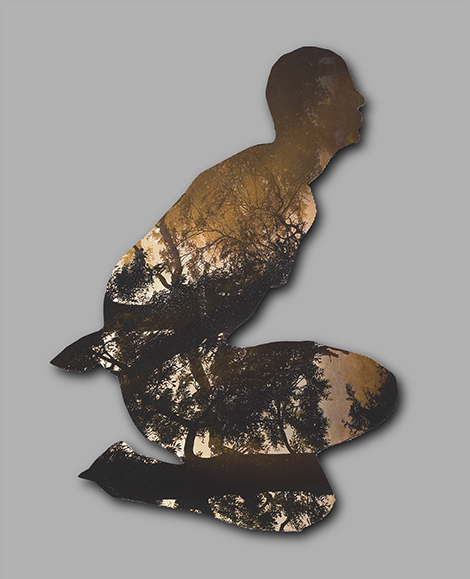A trio of sepia-toned photographs, displayed at the entrance of the Leila Heller Gallery, documenting four naked men followed by Western soldiers in a rundown village instantly evokes the horrors of Abu Ghraib.
The jarring scene—American soldiers humiliating local Iraqi’s for stealing—captured happenstance by two Norwegian journalists in Iraq serves as the back story to Iranian artist Reza Aramesh’s first solo exhibition of photomontages and sculpture (all 2015) at the gallery. Kindled by the impact and relevance of the images, the artist probes the underbelly of American occupation in the Middle East, and the spoils of prolonged incursions in Iraq.
In a series titled “Action”, multiple replications of a large cardboard silhouette of a man seated uncomfortably on his haunches with his hands bound behind his back becomes the frame and background for all the photomontages in the gallery. In one sequence, black and white collages of war, skirmishes, and dislocation are arranged on the silhouettes in such a way than any semblances of straightforward narratives are obscured. Mimicking chaos and turmoil, the placement of images acquired from the press and other public sources of blindfolded insurgents, incarceration, and inhumanity provides a cursory view of the actual conditions in Iraq. From these pictures and photographs taken by the European journalists, one can only imagine the indiscriminate use of power and subjugation. It is clear that punitive measures for the Middle Eastern prisoners far exceed what would be permissible in the West. The grand irony of American liberators in Iraq who easily slip into tyranny is not lost on the viewer.
In a second series, Aramesh incorporates colored images of the landscape onto the cardboard outlines. Trees and branches spread out like arteries on the prisoner’s bodies, while birds and the open horizon recall the beauty of yesteryear and infuse the frames with life. Yet Aramesh’s use of the shape of a compromised prisoner to present images of a highly-charged situation injects sentiment into the presentation. Although the artist’s choice of the male body as a symbol of torture in the Middle East is intended to illuminate both the difficultly of expressing pain and the political consequences of this inexpressibility, combining both images results in a maudlin conflation of politics with pity, and horror with tragedy. The very same neon-lit silhouette in the back room without the accompanying collages has greater visual resonance.
The accompanying white sculptures in memory of the naked prisoners’ clothes that were burned by the soldiers are effectively potent. Placed on charred wooden pedestals about a foot high, Aramesh’s white porcelain rendition of the clothing that dropped off the men’s bodies captures the fragility of human life. Through the palpable details of the folds and the intimacy of their physical belongings, the sculptures leave traces of the men’s presence by being substantially absent. Juxtaposed with the barbaric act of the incendiaries, these works remain branded in our mind’s eye.



